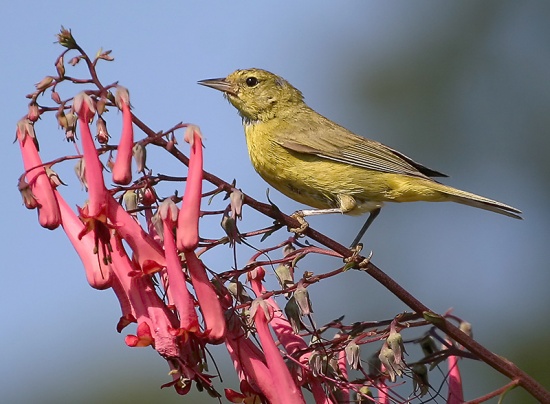| Line 1: | Line 1: | ||
;Vermivora celata | ;Vermivora celata | ||
| − | [[Image:Orange-crowned_Warbler.jpg|thumb|550px|right|Photo by janruss]] | + | [[Image:Orange-crowned_Warbler.jpg|thumb|550px|right|Photo by janruss <br/>Location: Edmonds, Washington, USA ]] |
==Identification== | ==Identification== | ||
| − | |||
| − | 4.25 inches | + | |
| + | 4.25 inches. Thin, very pointed bill, indistinct yellow supercilium, indistinct broken eye ring, grey to olive head, back, and wings, yellow to dull yellow/olive underparts with blurry, indistinct streaks on breast. Yellow undertail coverts. Females and immatures are somewhat duller. | ||
| + | |||
==Distribution== | ==Distribution== | ||
| − | + | [[United States]] | |
==Taxonomy== | ==Taxonomy== | ||
The Orange-crowned Warbler is divided into four subspecies that differ in plumage color, size, and molt patterns. The one named celata is found in Alaska and across Canada, and it is the dullest and grayest. The Pacific Coast form, lutescens, is the brightest yellow. Found throughout the Rocky Mountains and Great Basin, orestera is intermediate in appearance. The form sordida is the darkest green and is found only on the Channel Islands and locally along the coast of southern California and northern Baja California. | The Orange-crowned Warbler is divided into four subspecies that differ in plumage color, size, and molt patterns. The one named celata is found in Alaska and across Canada, and it is the dullest and grayest. The Pacific Coast form, lutescens, is the brightest yellow. Found throughout the Rocky Mountains and Great Basin, orestera is intermediate in appearance. The form sordida is the darkest green and is found only on the Channel Islands and locally along the coast of southern California and northern Baja California. | ||
==Habitat== | ==Habitat== | ||
| − | + | Forest edges, especially in low deciduous growth, burns, clearings, and thickets; often seen in riverside willows and scrub oak chaparral during migration. | |
==Behaviour== | ==Behaviour== | ||
| − | They forage actively in low shrubs, flying from perch to perch, sometimes hovering. | + | They forage actively in low shrubs, flying from perch to perch, sometimes hovering. The diet includes insects, berries and nectar. |
| − | |||
| − | |||
| − | |||
| − | |||
| − | + | The female chooses the nest site, which is usually on the ground under dense vegetation, but may be in a shrub, low tree, fern, or vine. She builds a small, open nest cup out of leaves, moss, small twigs, and bark, lined with fine grass and hair, and incubates 4 to 5 eggs for 11 to 13 days. Both parents feed the young. | |
| − | |||
==External Links== | ==External Links== | ||
*[http://www.birdforum.net/pp_gallery/showgallery.php?mcats=all&what=allfields&si=Orange-crowned+Warbler View more images of Orange-crowned Warbler in the gallery] | *[http://www.birdforum.net/pp_gallery/showgallery.php?mcats=all&what=allfields&si=Orange-crowned+Warbler View more images of Orange-crowned Warbler in the gallery] | ||
[[Category:Birds]] | [[Category:Birds]] | ||
Revision as of 15:13, 14 November 2007
- Vermivora celata
Identification
4.25 inches. Thin, very pointed bill, indistinct yellow supercilium, indistinct broken eye ring, grey to olive head, back, and wings, yellow to dull yellow/olive underparts with blurry, indistinct streaks on breast. Yellow undertail coverts. Females and immatures are somewhat duller.
Distribution
Taxonomy
The Orange-crowned Warbler is divided into four subspecies that differ in plumage color, size, and molt patterns. The one named celata is found in Alaska and across Canada, and it is the dullest and grayest. The Pacific Coast form, lutescens, is the brightest yellow. Found throughout the Rocky Mountains and Great Basin, orestera is intermediate in appearance. The form sordida is the darkest green and is found only on the Channel Islands and locally along the coast of southern California and northern Baja California.
Habitat
Forest edges, especially in low deciduous growth, burns, clearings, and thickets; often seen in riverside willows and scrub oak chaparral during migration.
Behaviour
They forage actively in low shrubs, flying from perch to perch, sometimes hovering. The diet includes insects, berries and nectar.
The female chooses the nest site, which is usually on the ground under dense vegetation, but may be in a shrub, low tree, fern, or vine. She builds a small, open nest cup out of leaves, moss, small twigs, and bark, lined with fine grass and hair, and incubates 4 to 5 eggs for 11 to 13 days. Both parents feed the young.




